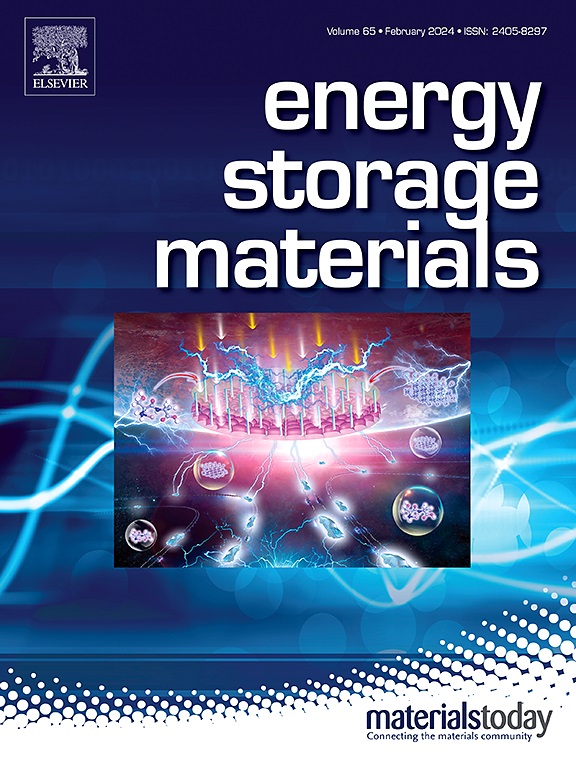一种具有亲电和亲核双中心的Janus结合剂,用于ah级四电子水溶液Zn-I2电池
IF 20.2
1区 材料科学
Q1 CHEMISTRY, PHYSICAL
引用次数: 0
摘要
四电子水溶液锌离子电池(4e AZIBs)由于其较高的理论能量密度,在电网规模储能方面极具吸引力。然而,由于I+的热力学不稳定性和电极的机械降解,在实际I2负载下稳定4e (I−/I2/I+)氧化还原转化仍然具有挑战性。为了解决这些问题,我们建议使用聚六亚甲基胍盐酸盐(PHMG),这是一种具有亲电和亲核中心的多功能粘合剂。PHMG中的亲核- nh -基团与I+形成稳定的电子转移配合物,抑制其在水溶液中的水解。同时,亲电的c =NH2+基团强锚定I3−,减缓了I3−和I+之间的比例反应。系统的理论模拟和光谱表征揭示了通过Janus粘合剂的选择性化学吸附来稳定I+。此外,定量纳米力学技术表明,PHMG粘合剂具有优异的力学性能,可以有效地承受电极结构的变化。因此,具有超高I2负载32.73 mg cm - 2的阴极可提供9.65 mAh cm - 2的面容量。更具体地说,实现了容量为0.76 Ah的4e Zn-I2袋电池,突出了其实际应用潜力。本研究提出了构建4e azib的新途径,特别是在高I2负载下。本文章由计算机程序翻译,如有差异,请以英文原文为准。


A Janus binder with electrophilic and nucleophilic dual centers for Ah-level four-electron aqueous Zn-I2 batteries
Four-electron aqueous Zn–I2 batteries (4e AZIBs) are extremely attractive for grid-scale energy storage owing to their high theoretical energy density. However, stabilizing 4e (I−/I2/I+) redox conversion under practical I2 loading remains challenging owing to the thermodynamic instability of I+ species and mechanical degradation of the electrode. To address these issues, herein, we propose the use of polyhexamethylene guanidine hydrochloride (PHMG), a multifunctional binder possessing electrophilic and nucleophilic centers. Nucleophilic –NH– groups in PHMG form stable electron-transfer complexes with I+, suppressing its hydrolysis in aqueous electrolyte. Meanwhile, electrophilic –C![]() NH2+ groups strongly anchor I3− species, mitigating the comproportionation reaction between I3− and I+. Systematic theoretical simulations and spectral characterizations reveal the stabilization of I+ via selective chemisorption by the Janus binder. Furthermore, quantitative nanomechanical techniques demonstrate that the PHMG binder exhibits excellent mechanical properties, effectively withstanding changes in the electrode structure. Consequently, a cathode with an ultrahigh I2 loading of 32.73 mg cm−2 delivers an areal capacity of 9.65 mAh cm−2. More specifically, a 4e Zn–I2 pouch cell delivering a capacity of 0.76 Ah is achieved, highlighting its practical application potential. This study presents a new route for constructing 4e AZIBs, especially under high I2 loading.
NH2+ groups strongly anchor I3− species, mitigating the comproportionation reaction between I3− and I+. Systematic theoretical simulations and spectral characterizations reveal the stabilization of I+ via selective chemisorption by the Janus binder. Furthermore, quantitative nanomechanical techniques demonstrate that the PHMG binder exhibits excellent mechanical properties, effectively withstanding changes in the electrode structure. Consequently, a cathode with an ultrahigh I2 loading of 32.73 mg cm−2 delivers an areal capacity of 9.65 mAh cm−2. More specifically, a 4e Zn–I2 pouch cell delivering a capacity of 0.76 Ah is achieved, highlighting its practical application potential. This study presents a new route for constructing 4e AZIBs, especially under high I2 loading.
求助全文
通过发布文献求助,成功后即可免费获取论文全文。
去求助
来源期刊

Energy Storage Materials
Materials Science-General Materials Science
CiteScore
33.00
自引率
5.90%
发文量
652
审稿时长
27 days
期刊介绍:
Energy Storage Materials is a global interdisciplinary journal dedicated to sharing scientific and technological advancements in materials and devices for advanced energy storage and related energy conversion, such as in metal-O2 batteries. The journal features comprehensive research articles, including full papers and short communications, as well as authoritative feature articles and reviews by leading experts in the field.
Energy Storage Materials covers a wide range of topics, including the synthesis, fabrication, structure, properties, performance, and technological applications of energy storage materials. Additionally, the journal explores strategies, policies, and developments in the field of energy storage materials and devices for sustainable energy.
Published papers are selected based on their scientific and technological significance, their ability to provide valuable new knowledge, and their relevance to the international research community.
 求助内容:
求助内容: 应助结果提醒方式:
应助结果提醒方式:


